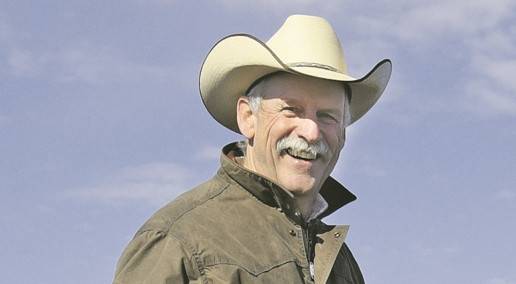Dr. Frank Mitloehner with the UC Davis CLEAR Centre opened the CFGA’s 14th annual conference, Forage Resilience in a Changing Landscape: Manage risk. Overcome challenges. Discover opportunities. on Nov. 29, 2023. His keynote address looked at livestock’s path to climate neutrality.
The main topic for this session was how greenhouse gases (GHGs) lead to climate change and the often-misunderstood role livestock play in this process. GHGs (carbon dioxide, methane, Chlorofluorocarbons (CFCs), ozone and nitrous oxide) play a very essential function by forming a blanket that keeps the earth’s surface warm by preventing some of the solar radiation from going back into space after reflecting off the earth’s surface. Without GHGs, life on earth wouldn’t be possible; it would be too cold. The problem is that humanity is putting too many GHGs into the air so the blanket is getting too thick. Most climate scientists point to the burning of fossil fuels as the main contributor, while some point to animal agriculture because methane is a very potent GHG.
There is misunderstanding about the methane cycle and its management and we need to understand and change the narrative profoundly. Looking at a quick breakdown of global GHG emissions by sector, we see 73 per cent comes from energy, with 18 per cent from agriculture, forestry and land use. About four per cent are direct emissions from livestock.
GWP100 is a metric used to quantify the warming impact of methane and nitrous oxide in comparison with carbon dioxide (CO2). It says that methane (CH4) is 28 times more powerful than CO2 and nitrous oxide is 265 times more powerful. This has given animal agriculture a very bad reputation because the nuances of the methane cycle are not considered in this method.
Methane requires special consideration because the natural methane sinks have not been considered in the GWP100. In the natural cycle, the total emissions (558 teragrams (tg)) are nearly balanced by the natural sinks for methane (548 tg), leaving only 10 tg that needs to be addressed. Methane is a short-lived climate pollutant, with a relatively rapid natural cycle. Hydroxyl radicals destroy methane within 12 years in the atmospheric removal process which is the main methane sink. The dominant narrative ignores the sinks and does a disservice to the animal agriculture industry.
Does a constant cattle herd cause additional warming? Does the carbon that the cattle are belching add additional carbon to the atmosphere? No. That carbon was already in the atmosphere in the form of CO2. Now it’s in the form of CH4 for about a decade before it is cycled back into CO2. Therefore, a constant cattle herd does not contribute to additional warming because the constant source of methane is balanced by an equal process of its breakdown.
GWP100 overestimates the warming impact from methane of constant-sized herds and overlooks its ability to induce cooling when CH4 emissions are reduced. GWP* is a new metric developed by scientists from the University of Oxford that considers the short-lived nature of methane as well as its atmospheric removal.
Every time we burn fossil fuel, CO2 is produced and adds up. With GWP100, methane is treated the same way, as if we are continually stockpiling methane in the atmosphere, completely ignoring the natural cycle of atmospheric removal. If we only use GWP100 to characterize methane’s impact on climate, we will overestimate impact of constant methane emissions on warming by a factor of four over 20 years, a fact recognized by the Intergovernmental Panel for Climate Change (IPCC).
Methane is a flow gas which means its atmospheric concentration is stagnant, as they are destroyed at the same rate as production, whereas CO2 is a stock gas which accumulates in the environment overtime. Under constant emissions (steady herd size) this means the warming effect of methane has a flat line shape while CO2 linearly increases warming. Under falling emission conditions, CO2’s contribution to warming will plateau, while CH4’s will cause cooling. GWP100 completely fails to acknowledge this, but the new metric GWP* captures it.
There are many efforts being made to further reduce methane emissions on farms. For example, in California, a voluntary incentive-based approach, has already supported dairy farmers to reduce GHG emissions by over 30 per cent of the sector’s goal using natural gas digesters (which also bring in income for the dairies). Feed additives and breeding techniques are also being studied for their methane reduction potential.
Methane is a problem if we fail to manage it. But by using tools already available, it’s possible to reduce emissions and lower the sector’s environmental impact, leading to agriculture being part of the climate solution.
Access to the recordings of the 2023 conference proceedings will be available for purchase soon. If you would like to know when they become available email [email protected].
Additional Information:
California’s pathway to significant dairy methane reduction
Back to Most Recent



Leave a Comment